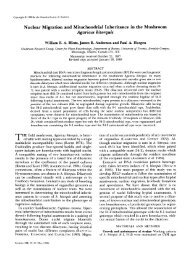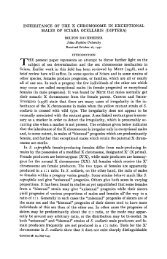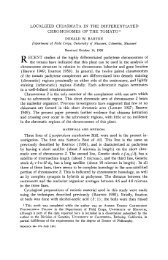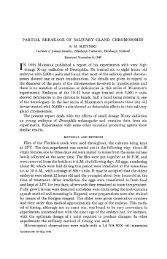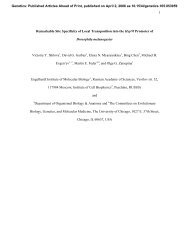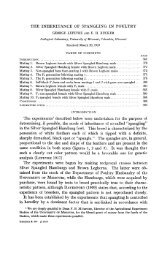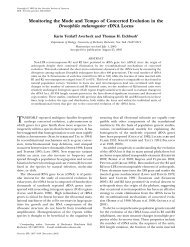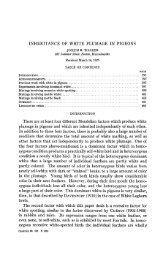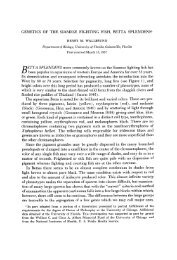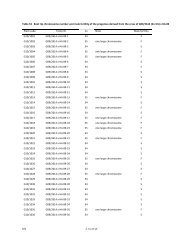abstracts of papers presented at the 1962 meetings - Genetics
abstracts of papers presented at the 1962 meetings - Genetics
abstracts of papers presented at the 1962 meetings - Genetics
You also want an ePaper? Increase the reach of your titles
YUMPU automatically turns print PDFs into web optimized ePapers that Google loves.
ABSTRACTS 983<br />
enzyme syn<strong>the</strong>sis.-Five alleles <strong>of</strong> <strong>the</strong> E gene, E", EL, EN, ER, and ES, specify five electropho-<br />
retically distinguishable forms <strong>of</strong> <strong>the</strong> pH 7.5 esterase enzyme in maize and teosinte. This en-<br />
zyme is found in <strong>the</strong> developing endosperm as well as in <strong>the</strong> developing embryo, seedling and<br />
plant tissue. Two new mutants design<strong>at</strong>ed E"' and Est are indistinguishable from EF and E" in<br />
<strong>the</strong>ir behavior in <strong>the</strong> diploid tissue, but in <strong>the</strong> endosperm are characterized by a precocious sus-<br />
pension <strong>of</strong> gene action. The activity <strong>of</strong> EF' is cut <strong>of</strong>f earlier than ES'. In heterozygotes with a nor-<br />
mal-acting allele, as for example EF'/EF'/EN, both alleles are equally active in <strong>the</strong> young endo-<br />
sperm (14 days after pollin<strong>at</strong>ion) and three enzyme bands are observed in zone electrophoresis,<br />
intense FF and FN hybrid, and a weak NN. By 20 days after pollin<strong>at</strong>ion <strong>the</strong> EF' allele is com-<br />
pletely inactive while <strong>the</strong> EN allele still shows full activity and only a single esterase type, NN,<br />
is present in <strong>the</strong> endosperm. These regul<strong>at</strong>ory mutants involve alter<strong>at</strong>ions <strong>at</strong> or close to <strong>the</strong> site <strong>of</strong><br />
<strong>the</strong> structural gene since no recombin<strong>at</strong>ions have been found in more than 2500 endosperms<br />
tested.<br />
SEARS, E. R., U. S. Department <strong>of</strong> Agriculture and University <strong>of</strong> Missouri, Columbia, MO.:<br />
The use <strong>of</strong> telocentric chromosomes in linkage mapping.-Telocentric chromosomes, which are<br />
readily obtainable in common whe<strong>at</strong> through misdivision <strong>of</strong> monosomes, not only permit <strong>the</strong> assignment<br />
<strong>of</strong> genes to particular chromosome arms but also make possible <strong>the</strong> determin<strong>at</strong>ion <strong>of</strong><br />
gene-centromere distances. For example, <strong>the</strong> long arm <strong>of</strong> chromosome 6B carries <strong>the</strong> awn inhibitor<br />
B,. To determine <strong>the</strong> distance <strong>of</strong> B, from <strong>the</strong> centromere, a telocentric carrying B, was<br />
combined with a normal chromosome carrying b,. When <strong>the</strong> plants concerned were used as<br />
males in a testcross, only six <strong>of</strong> 231 <strong>of</strong>fspring had B,. Two <strong>of</strong> <strong>the</strong>se six possessed <strong>the</strong> p<strong>at</strong>ernal<br />
telocentric and were thus noncrossovers, and three had both p<strong>at</strong>ernal chromosomes and <strong>the</strong>refore<br />
could not be scored. Thus crossing-over between B, and <strong>the</strong> centromere was only 1/228 or<br />
O.M%. In <strong>the</strong> same experiment ano<strong>the</strong>r gene on this arm, Sr,, (stem-rust resistance from <strong>the</strong><br />
variety Timstein), showed M.3 2 3.2% recombin<strong>at</strong>ion with <strong>the</strong> centromere. In a second experiment<br />
presence <strong>of</strong> a marker on <strong>the</strong> short (nucleolar) arm <strong>of</strong> <strong>the</strong> normal 6B allowed use <strong>of</strong> <strong>the</strong><br />
heterozygote as <strong>the</strong> female, and presence <strong>of</strong> a gene a few units proximal to Sr,, permitted<br />
detection <strong>of</strong> some <strong>of</strong> <strong>the</strong> double crossovers. Here crossing-over between Sr,, and <strong>the</strong> centromere<br />
was 49/98 or 50%. The gene proximal to Sr,,, pollen-killer (Ki), showed 9.2 *2.9% recombin<strong>at</strong>ion<br />
with Sr,,. In this and a third experiment not involving Sr,,, recombin<strong>at</strong>ion between<br />
Ki and <strong>the</strong> centromere was 43.1% 2 3,5%.-Ne<strong>at</strong>by's virescent (U) on chromosome 3B showed<br />
only 0.29% recombin<strong>at</strong>ion with <strong>the</strong> centromere in 350 gametes tested.<br />
SEECOF, R. L., Calif. Institute <strong>of</strong> Technology, Pasadena, Calif.: Tre<strong>at</strong>ment <strong>of</strong> eggs from carbon<br />
dioxide sensitive Drosophila with X-rays and ultrauiolet radi<strong>at</strong>ion.-Eggs were collected from<br />
females <strong>of</strong> a stabilized, carbon dioxide sensitive strain <strong>of</strong> Drosophila melanogaster, irradi<strong>at</strong>ed with<br />
X-rays or ultraviolet light, and permitted to develop into adult flies. The titer <strong>of</strong> <strong>the</strong> virus-like<br />
factor (sigma factor) causing <strong>the</strong> sensitivity was measured in <strong>the</strong>se adults and compared to <strong>the</strong><br />
titer in adults th<strong>at</strong> developed from untre<strong>at</strong>ed eggs. Ultraviolet radi<strong>at</strong>ion from a germicidal lamp<br />
in doses <strong>of</strong> 2.00-600 ergs/mm2 (mortality 154%) caused 4-8-fold increases in titer. Higher<br />
doses were not effective in raising titers. X-ray tre<strong>at</strong>ments in a range giving u)-70% mortality<br />
failed to cause measurable changes in titer. The titer increases following ultraviolet light tre<strong>at</strong>ment<br />
were significant in all <strong>of</strong> <strong>the</strong> three experiments done to d<strong>at</strong>e, but more elabor<strong>at</strong>e control<br />
experiments are needed to establish <strong>the</strong> effect. Experiments are now being done to confirm <strong>the</strong><br />
titer increases and to determine whe<strong>the</strong>r <strong>the</strong> titer increases represent an induction <strong>of</strong> infectious<br />
sigma from a noninfectious stage in <strong>the</strong> sigma life cycle.<br />
SHAMA RAO, H. K., and E. R. SEARS, Atomic Energy Estab., Trombay, India, and U.S. Department<br />
<strong>of</strong> Agriculture, Columbia, MO.: EMS-induced mut<strong>at</strong>ions in hexaploid whe<strong>at</strong>.-Seeds <strong>of</strong><br />
normal Chinese Spring whe<strong>at</strong> and <strong>of</strong> monosomics 2B and 6B <strong>of</strong> this variety <strong>at</strong> 12% moisture<br />
were soaked in 0.05 M ethyl methanesulfon<strong>at</strong>e <strong>at</strong> 30°C for six hours, a tre<strong>at</strong>ment which permitted





